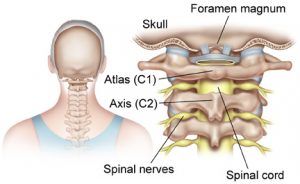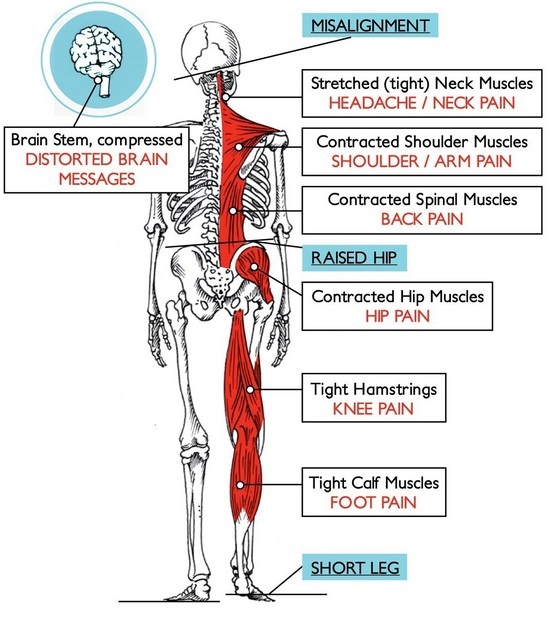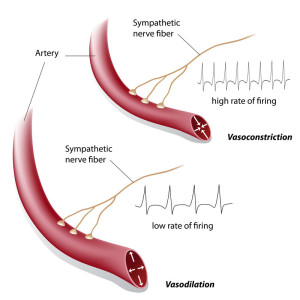The atlas vertebra plays a unique role in the maintenance of healthy neurological function.
Along with the lower portion of the skull, the atlas protects the most highly specialized and complex portion of the central nervous system–the brain stem. At the same time, the atlas connects above and below with the skull and the second bone in the neck to comprise one of the most complex joint systems in the body.
Small misalignments between the head and the atlas affect communication between the brain and body.
The brain and brain stem orchestrate the complex interactions between each cell, tissue and organ in the human body in order to achieve a single goal: health. When the brain or brain stem lose their connection to one or more parts of the body, we fall short of that goal. The signs and symptoms that accompany any loss of health are clues that help us discover and correct the cause.
Here are three of the most common effects of atlas misalignment and how they impact your health.
1) Spastic Contracture: Muscles that contract more on one side of the body than the other side
 Resting muscle tone is controlled by nerves that originate in the lower part of the brain stem. When the atlas misaligns, the function of these nerves is disrupted and the muscles along one side of the spine are allowed to contract more than they should. This imbalance between the left and right side of the body causes the entire spine and pelvis to twist slightly out of normal alignment, resulting in pain, stiffness and irritation to nerves that can cause numbness, tingling and burning sensations.
Resting muscle tone is controlled by nerves that originate in the lower part of the brain stem. When the atlas misaligns, the function of these nerves is disrupted and the muscles along one side of the spine are allowed to contract more than they should. This imbalance between the left and right side of the body causes the entire spine and pelvis to twist slightly out of normal alignment, resulting in pain, stiffness and irritation to nerves that can cause numbness, tingling and burning sensations.
Often these symptoms are temporarily relieved by adjustments to the different parts of the spine and pelvis, only to return a short time later. The adjustment is able to realign part of the spine for a short period of time, but because the atlas hasn’t been properly aligned, abnormal muscle tone remains and the alignment is short-lived and unstable.
When the position of the atlas is corrected, many patients are surprised that their low back pain or sciatica disappears. How can pain in the lower spine and leg resolve when only the upper part of the neck has been worked on? The key is understanding that distant parts of the body are all connected to nerves that originate high in the neck in the brain and brain stem.
*Note: The muscle imbalance known as spastic contracture is most often responsible for the often diagnosed “short leg”. When the pelvis is twisted, the hip socket shifts upward and causes one leg to appear shorter than the other. Many patients realize they have this “short leg”, but are never told that it can be corrected.
2) Circulatory problems
Your body’s ability to provide adequate blood flow to every cell, tissue and organ is essential. When part of the body stops receiving normal blood supply, it slowly loses its ability to function and becomes prone to infection and disease. Swelling, fatigue and depressed immune function will also develop when circulation is impaired.
Blood vessels are lined with a special type of muscle called smooth muscle which is controlled by specialized nerves that make up the autonomic nervous system. Atlas misalignment commonly causes smooth muscle in blood vessels to contract inappropriately. When this occurs in the ears and eustachian tubes of infants and young children, for example, the fluid in the ear canal isn’t able to drain and becomes a breeding ground for bacteria. This is why some children suffer with repeated ear infections despite the frequent use of antibiotics. It also explains the effectiveness of atlas correction in relieving the pain and misery associated with these chronic ear infections.
A misaligned atlas doesn’t just affect the smooth muscle in blood vessels though. Dysfunction of smooth muscle in the digestive system can lead to confusing digestive problems; smooth muscle dysfunction in the respiratory tract can lead to breathing problems like asthma, sleep apnea and snoring; when smooth muscle in the uterus or reproductive tracts dysfunctions, painful menstrual periods and infertility can result.
And when it comes to circulatory problems associated with atlas misalignment, blood isn’t the only fluid that is affected. Cerebrospinal fluid (CSF) is produced by special cells in the brain and this fluid must circulate down along the entire spinal column, providing mechanical and immunological protection to the central nervous system. Atlas misalignment directly disrupts the flow of CSF and has been shown to cause increases in pressure inside the skull. This pressure can lead to migraine headache and serious neurological disease when left uncorrected.
3) Dysafferentation: incorrect processing from from sensory organs
Every joint in your body contains receptors that continually send information to brain about the position each part of the body. These receptors play an important role in the maintenance of balance and equilibrium, as well cardiovascular function and perception of pain.
The joints formed by the atlas vertebra are some of the most densely populated with these receptors. Atlas misalignment is a major cause of loss of equilibrium such as vertigo and other balance related syndromes. This occurs because the joint surfaces are locked into and abnormal position and send faulty information to the brain about where the head is located compared to the rest of the body and compared to gravity. Individuals will often notice dizziness or spinning when turning their head or getting up and lying down.
Cardiovascular function relies heavily on these receptors as well. Regulatory mechanisms such as blood pressure rely continually on the information supplied by these joint receptors.
The upper cervical spine plays an extremely important role in the maintenance of many of the functions contributing to optimal health and well-being.
It’s important to recognize when the signs and symptoms associated with health problems indicate involvement of head and neck alignment so that correctable problems don’t become chronic or life-altering.
NUCCA practitioners are uniquely qualified and trained to detect, accurately analyze and competently correct the atlas misalignment. The NUCCA organization has a tool on their website that will allow you to search for a NUCCA practitioner in your area.
*Note: There are three levels of certification that correspond to the skill level that the practitioner has been able to objectively demonstrate to the NUCCA Certification Board. When searching for a practitioner, pay attention to their level of certification and try to choose the doctor with the highest level of certification.
